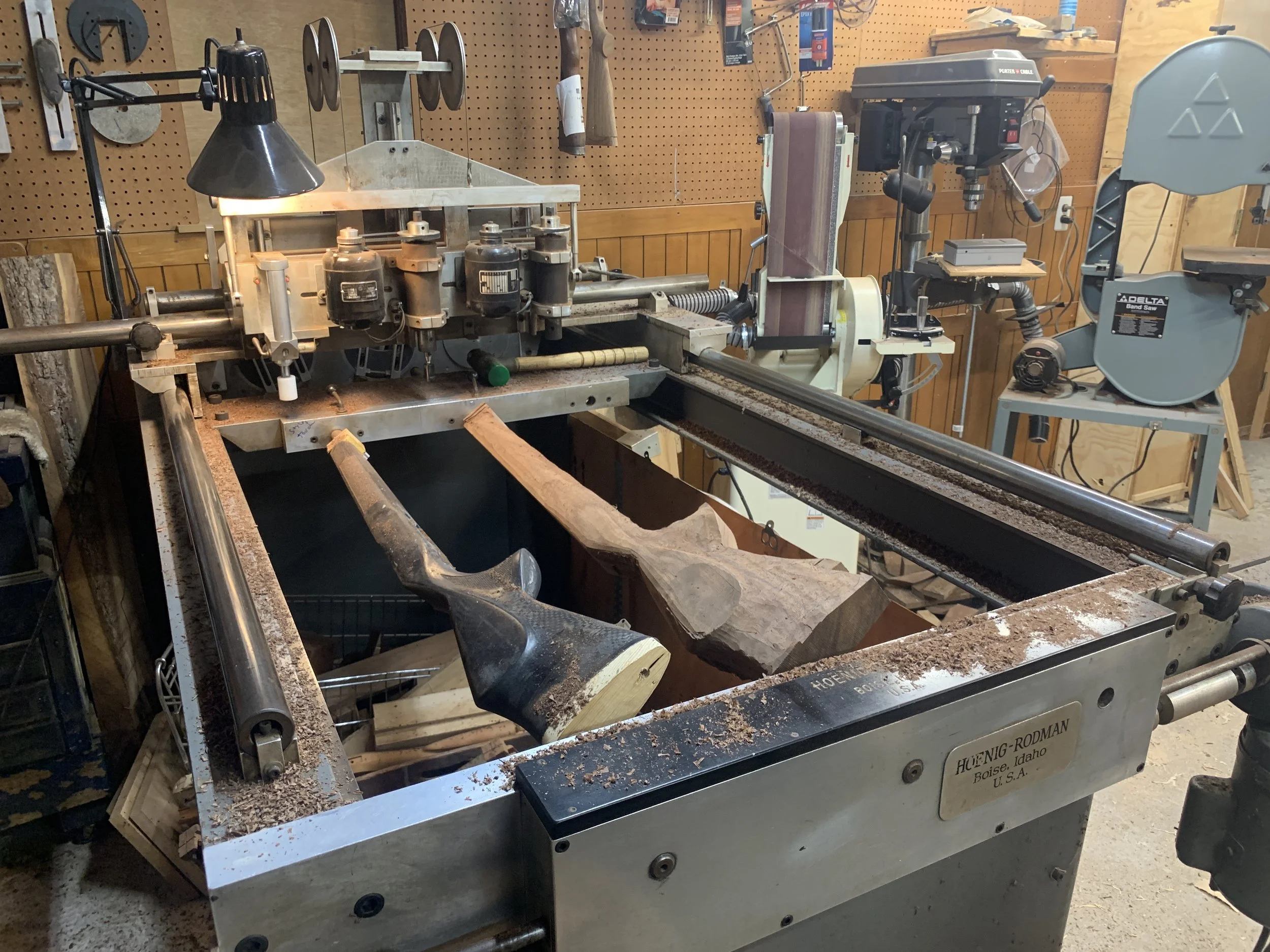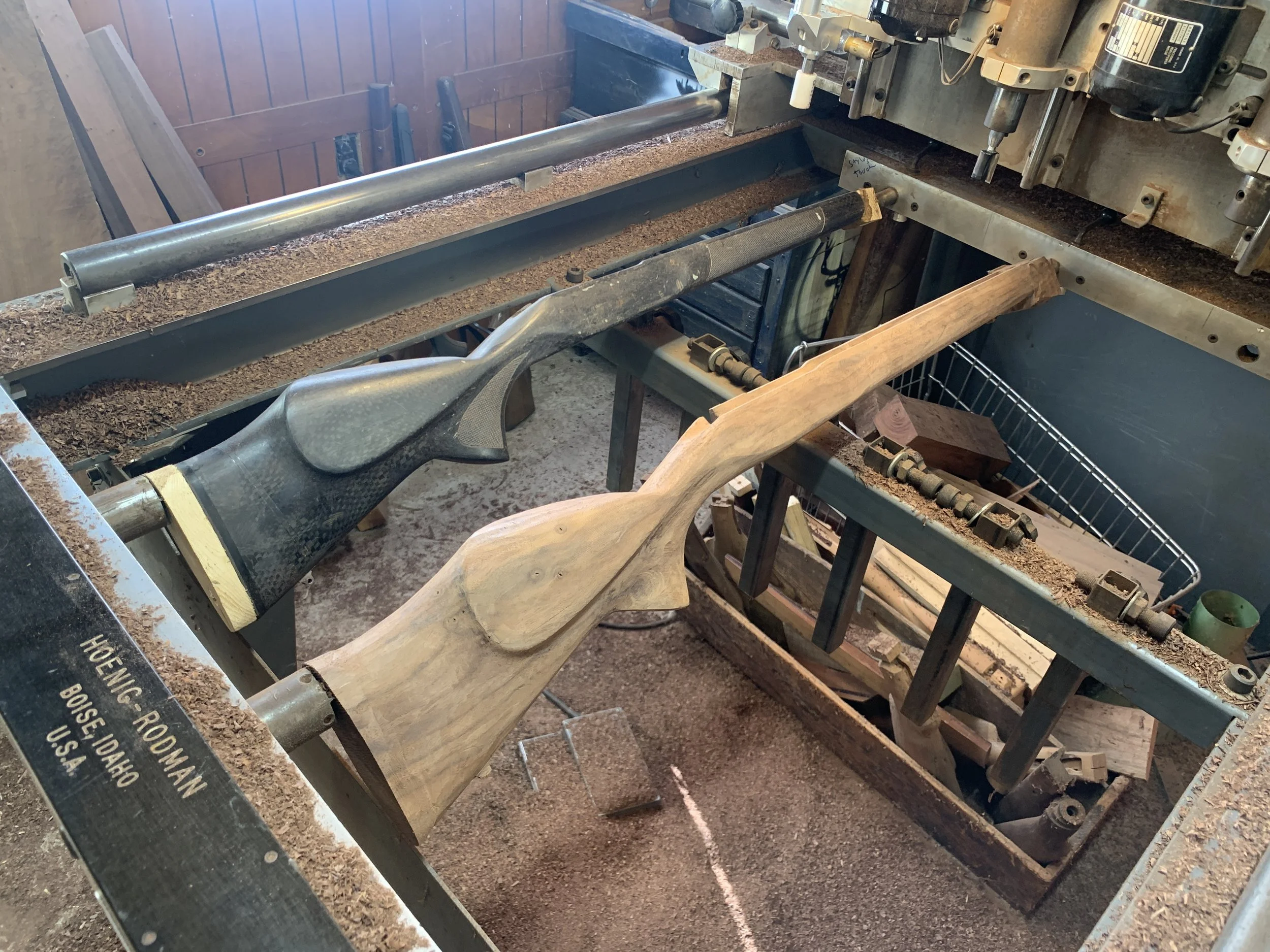Stock Duplication: Detailed Pricing & All Your Questions Answered
Stock Duplication is not as simple as it sounds. There are a lot of different processes involved with machining an accurate copy of a stock. Here I am going to explain to you what the process is that I do and what you need to consider if you would like to hire me to cut a stock for you. I will explain as much as I can and at the end give a more detailed explanation of what you can expect pricing-wise.
The Machine
I am one of the lucky few to have a Hoenig-Rodman Duplicator in my shop. Widely considered to be the best duplicator ever made, this machine is a 5-axis machine and can cut with extreme accuracy when setup and leveled correctly. Weighing in at well over 1000 lbs, this takes up a lot of real estate in the shop.
The history on this machine is hard to find and I welcome anyone to contact me with more information on these machines. George Hoenig, the inventor of the legendary round action, designed and made these machines. An accurate reloading forum post from 2005 states, “George Hoenig used to make around three a year and he would not put you on a list. You had to be one of the first three that called him at the beginning of the year,” and that they sold for over $20,000 at that time. Patented in 1973, the duplicator is stockmaker’s dream machine. How I found and bought mine is a story in itself. A much longer piece on the history of this machine is needed, and I will try my best to write that piece in the near future.
The Process
The duplication process is much more complex than just putting a stock in and tracing it. There is a lot more involved.
The pattern and blank are then put into the duplicator and traced with a stylus to make sure that there is enough wood on the blank prior to cutting. Once that is confirmed, I scribe a line, using the duplicator, to 1/8” larger than final dimension. The longest part of the duplication process is this initial roughing out. So, the more I can cut off with the bandsaw beforehand, the more time it saves me.
At this point, if the blank needs a thru hole for a stock bolt or mag tube, it is drilled on the lathe. This ensures that the hole is straight and doesn’t wander. This is a whole process in itself that can be explained later down the road. The thru hole becomes the center by inserting and gluing in a dowel rod which will be drilled out later on.
After the blank is rough cut on the bandsaw 1/8” larger than final dimension, I put it back in the duplicator and again trace it with the stylus to ensure that we have enough wood. Once confirmed, I ensure there is no backlash in the machine and start cutting. To get an 1/8” larger on all dimensions, I use a 1-inch stylus and 3/4” cutter that is raised 1/8”. This process will take up to a couple hours depending on the complexity of the stock.
Next, the stock is pulled out of the machine and allowed to rest for at least a day. This will allow the wood to twist and turn after the bulk of the wood has been cut. All the stresses in the wood will be mostly relieved at this point. For long mannlicher length stocks, I usually extend this period to a week or two as the forearms tend to be very thin.
After the wood is relieved of its stress, the stock is put back into the duplicator for inletting. This is where the Hoenig really shines. I have steady rests and various holders that ensure the stock doesn’t flex at all during the inletting cuts. I set up dial indicators to make sure that everything is lined up prior to cutting. I start with the top side of the stock, flip it over, then do the underside of the stock. If it has side locks or any inletting similar, those are cut next.
At this point the stock is 1/8” proud and inlet to desired dimensions, or about 95% of final dimension. Meaning there is still hand work involved. Everything above is part of the basic pricing, anything below is additional.
Reducing the external profile of the stock to either 1/16” or 1/32” is then done if requested. This involves tracing the entire exterior profile of the stock again. Once for the 1/16”, and twice for the 1/32” option. Again, this extra cost is just my time on the machine.
FAQs:
Do you have stock blanks available?
At this moment I do not have a lot of stock blanks on hand, and the ones I do have on hand are only available to those that physically visit the shop. I can source a blank for you but that will be an additional cost in time. If you would like to use your own blank I will need to look at it an approve it prior to cutting. I have examined hundreds of stock blanks in the past few years and can save you a headache later on if there are any hidden knots or voids in the wood. I prefer to only use wood that has been air dried for at least 5 years. Kiln dried wood can be used but is more susceptible to changes in moisture in the air.
What is a pattern stock?
A pattern stock is what I trace with the stylus on the duplicator. These are typically made with old stocks or made from scratch based on my styling. A pattern is the most important part of a duplication. If the pattern stock has gaps in the inletting, your duplication will as well. If you supply a pattern, I highly recommend glass bedding the inletting prior for the closest fit. If you supply the old stock and allow me to keep it for future use as a pattern I will discount your total price.
Do you have patterns on hand?
Yes, primarily over/under and side by side shotgun stocks. I do not have a list of what is on hand yet as many of them came with the duplicator and are not labeled. I am working on increasing my stock of bolt action patterns so that you can have more styles to choose from.
What are your lead times for stock duplication?
Lead times depend on what I receive from the customer. I do duplications in the order I receive them, but ones that require the least amount of work will usually move up the list. By least amount of work I mean that a pattern and blank are supplied.
Pricing
Basic Pattern Fabrication is included with the pricing. Basic is defined as me simply gluing on wood blocks to the front and back of the pattern to hold between centers on the duplicator. Any pattern fabrication beyond that will be charge hourly.
Base prices below include profiling the stock leaving 1/8” extra material on the exterior. Reducing the exterior profile to 1/16” or 1/32” will be an additional charge that is outlined below.
Pattern Fabrication - Hourly
One Piece Bolt Action Rifle Stock - $300
One Piece Mannlicher Length Rifle Stock - $400
Shotgun or Lever Action Buttstock - $250
Shotgun or Lever Action Forend - $150
Over/Under Forearm - $225
Add-Ons:
Reduce Exterior Profile to 1/16” extra + $50 (For two piece stocks, this covers both the buttstock & forend)
Reduce Exterior Profile to 1/32” extra + $75 (For two piece stocks, this covers both the buttstock & forend)
Through hole for Buttstock or Magtube + $40 per hole
If you would like me to inlet or finish your stock entirely please let me know in the “Description” on the form below. This will be an hourly charge and pricing can be wildly different depending on the complexity of the inletting.


